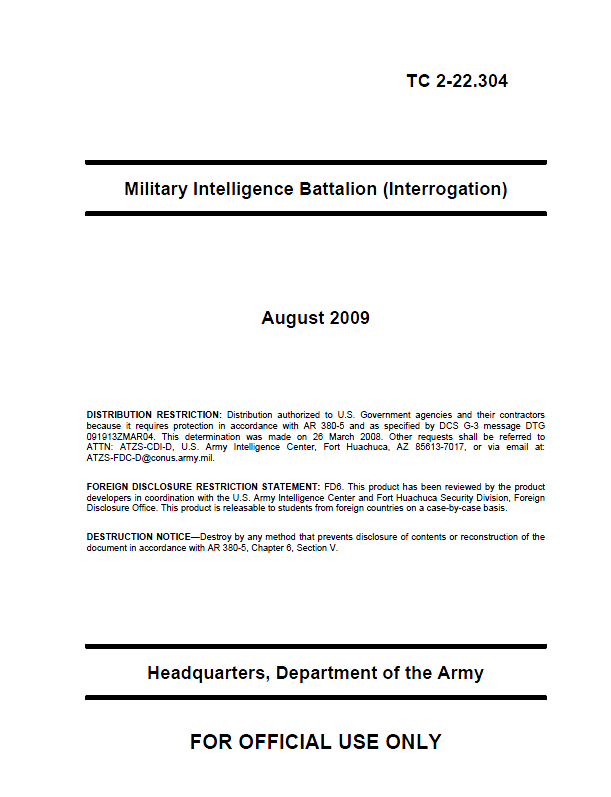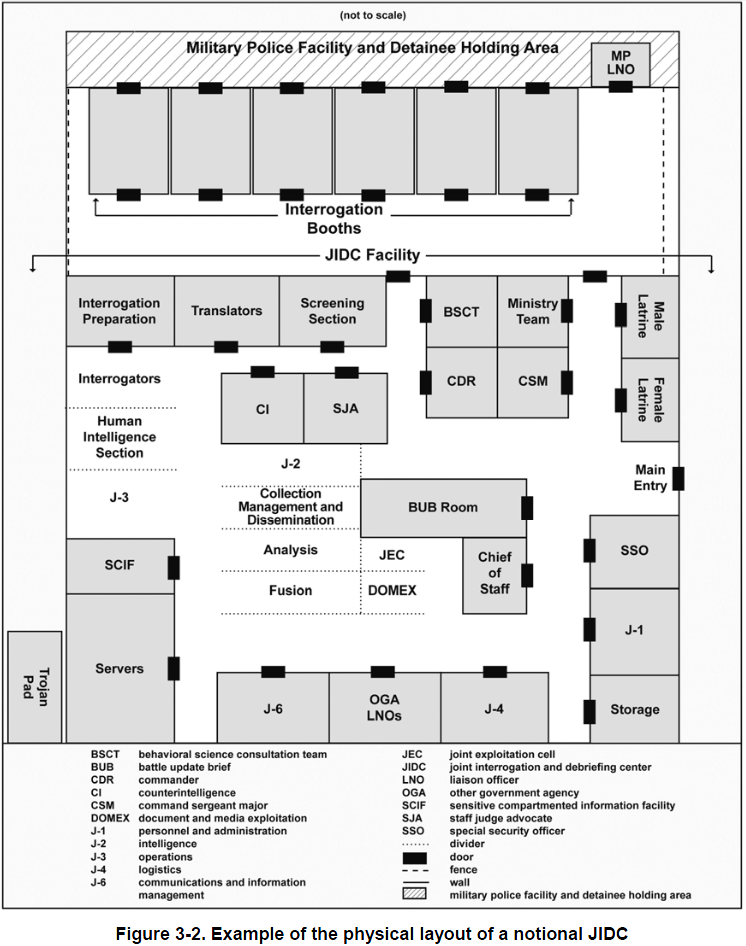TC 2-22.304 Military Intelligence Battalion (Interrogation)
- 62 pages
- For Official Use Only
- August 2009
TC 2-22.304 provides doctrinal guidance concerning the military intelligence (MI) battalion (interrogation). The TC complements existing doctrine, in particular FM 2-22.3, and incorporates lessons learned from recent operations. The MI battalion (interrogation) is specifically designed to operate within a joint interrogation and debriefing center (JIDC). The battalion command, staff, personnel, and equipment form the nucleus of the JIDC. The battalion is task-organized and augmented with additional personnel from other Services, Government civilians, and civilian contractors to form a JIDC.
The TC discusses MI battalion (interrogation) operations through the lens of the Army force generation (ARFORGEN) process—a structured progression of increased unit readiness, over time, resulting in recurring periods of availability. This discussion can help personnel, assigned to or supporting a MI battalion (interrogation), to focus on tasks they need to accomplish, no matter where they are in the readiness cycle. This TC—
• Fills a gap in existing intelligence documentation on how a MI battalion (interrogation) operates.
• Addresses recommendations that doctrine be developed for the organization and operation of a JIDC, which derives from AR 15-6 investigation of the Abu Ghraib detention facility and the 205th MI Brigade.
• Complies with the Army Campaign Plan 2008 direction to have the U.S. Army Training and Doctrine Command (TRADOC) develop doctrine to guide employment of the current and future modular force in joint operations.
• Targets as an audience the MI battalion (interrogation) commander, staff, and assigned or supporting personnel (military, Government civilians, and civilian contractors).
• Serves as a reference for planners, doctrine writers, training developers, trainers, materiel developers, capability managers, concept developers, requirements developers, and other personnel addressing issues related to a MI battalion (interrogation).
• Uses the historical Army doctrinal terms “collection management” and “collection management and dissemination,” which are currently used in manning documents such as the MI battalion (interrogation) objective table of organization and equipment (OTOE) and the JIDC joint manning document (JMD).This TC is unclassified, but marked FOR OFFICIAL USE ONLY (FOUO). Therefore, certain safeguards should be taken—do not discard the TC in an open trash, make available to the public, or post it on an uncontrolled web site. It can, however, be shared with individuals on a need to know basis. This TC intentionally refrains from addressing any classified topics or references in order to facilitate foreign disclosure to coalition partners (if operationally required) for use in multinational operations. See AR 380-5, which prescribes procedures for the safeguarding of defense information.
…
3-11. When setting up an area for long-term interrogation operations, interrogators should provide proper lighting, climate control, seating, workspace and materials, monitoring, safety, and security. Not every approach technique requires special preparation of the interrogation area, but interrogators should have the option to arrange seating, lighting, or other props in the area to create the appropriate atmosphere to support their selected approach strategies. Interrogators may want to provide a relaxed atmosphere for a rapport-based approach, a business-like area resembling an office to support a ruse, or perhaps a sterile “prison cell-like” booth for a fear-based or futility approach. They should acknowledge what the local populace considers as a relaxed, business-like, or “prison cell-like” atmosphere, and not rely solely on what the average American considers as typical of each type of atmosphere. If time, resources, and space allow, constructing booths to support each of the scenarios listed above should be considered.
3-12. Listed are general guidelines for booth construction in order to keep the interrogation booth and surrounding area free from distractions, such as external stimuli like the view from a window, music sounds, talking, or pictures on the walls of the booth. If the booth has windows, they should be covered or high enough to provide no view.
…
HUMAN INTELLIGENCE COLLECTOR AND ANALYST TEAMS
3-32. Human intelligence collector and analyst teams may be assigned team members who are cleared interpreters, behavioral science consultants, representatives from other intelligence collections agencies or activities, law enforcement personnel, or other subject matter experts (SMEs). Participation by other agencies on the teams enhances agencies’ ability to share information. These teams may focus on specific areas, regions, or target sets, for example, tribal groups, bomb makers, terrorist organizations, political parties, foreign fighters, or other issues of intelligence interest. The teams are designed so analysts can provide HUMINT collectors with guidance and direction on collection topics for sources. In this respect, the interrogators support the analyst rather than the other way around. The arrangement makes sense, considering the purpose for intelligence interrogation is to obtain information that satisfies intelligence requirements—supported commanders’ PIRs, national requirements, or source-directed requirements (SDRs).
3-33. Brainstorming—before and after an interrogation session—focuses collection. The collector and analyst decide when the analyst should attend a particular interrogation session, especially a particularly difficult session or when new information becomes available.
3-34. Analysts should be available to view interrogation sessions, either directly in the interrogation booth or from the observation room. Analysts can often spot leads that the HUMINT collector misses or suggest topics for follow-up. If the HUMINT collector and analyst decide the analyst should take an active role in the interrogation session, they should acknowledge that the HUMINT collector is in charge of the interrogation, regardless of the interrogation’s progress. The interrogator provides any incentives offered; controls the interrogation plan, progression, and schedule; and sets the topics for exploitation.
3-35. The analyst should be aware that the detainee might seek information as well. HUMINT collectors are trained to maintain control of the interrogation session, but analysts and other active participants in the interrogation session generally are not. These individuals should follow the HUMINT collector’s lead and direction to preclude the detainee from gaining control.
3-36. If the analyst observes the interrogation session from outside the booth, reviewing the analyst support package or other sources of information while the interrogation is in progress enables the analyst to advise the HUMINT collector, during breaks.
3-37. Before terminating an interrogation session, the HUMINT collector should confirm with the analyst any new topics to exploit from the research, or whether the analyst identified any leads the HUMINT collector failed to fully exploit.
…
CULTURAL AWARENESS TRAINING
B-5. Cultural awareness classes given to deploying Soldiers center on explaining the mindset of devout, fundamentalist religious or political groups. However, the detainees questioned are often secular. They may be associated with the prevailing religious or political beliefs, but do not adhere to all the tenants or requirements.
B-6. HUMINT collector tactics designed to focus on the motivations of the fundamentalist religious or political groups may be ineffective on the more secular detainees who are drawn into extremist groups. They are motivated by their social contacts rather than by their religious or political beliefs. Therefore, cultural awareness classes designed for HUMINT collectors should focus not only on the views of the major religions and political parties in the theater of operations but also on secular beliefs and motivations.
B-7. Cultural awareness classes should be detailed and targeted to Soldiers’ regions of deployment or to detainees’ places of origin. A study of the social, historical, tribal, familial, religious, and other factors centered on a region reveals explicable and exploitable motivations not present in the national population, as a whole.
B-8. HUMINT collectors and analysts should comprehend how other cultures perceive the United States and its multinational partners. Propaganda or false or exaggerated reporting by local or regional news sources—influenced or controlled by threat governments—overwhelm the indigenous populace of the theater of operations. HUMINT collectors should prepare to either counter the skewed perceptions or use them to their advantage.
B-9. HUMINT collectors should consider the following factors when preparing to conduct operations in a particular theater of operations:
- What constitutes a family unit.
- Religion practices and how devoutly.
- Basis of the economy.
- Relationships between populations of regions, cities, and even neighborhoods.
- Populations’ perceptions of their place in the world.
These and other factors affect HUMINT collectors’ decisionmaking when attempting to gain their sources’ cooperation.
…


